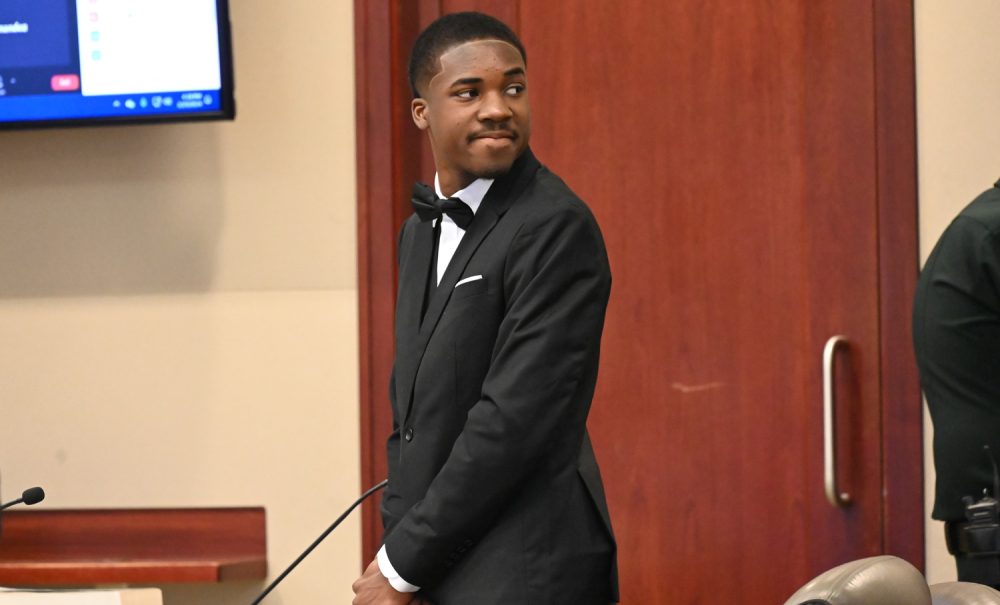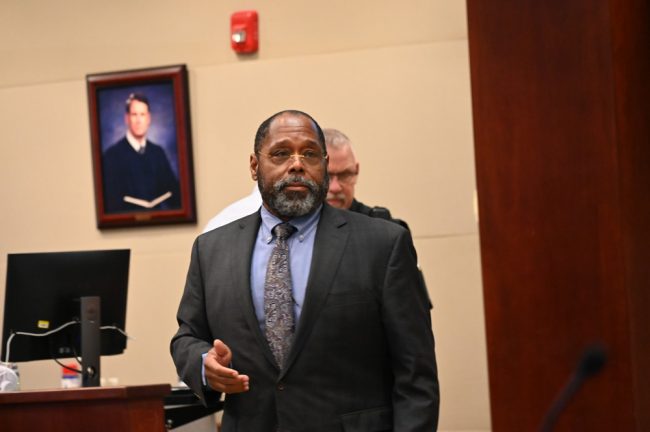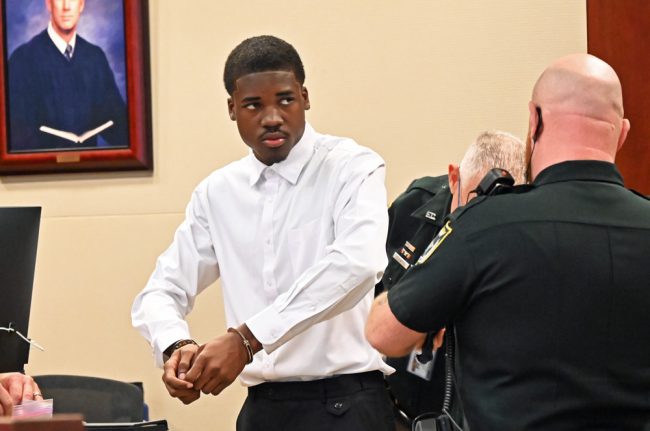
“On that evening or early morning, two lives were permanently and irretrievably changed,” Circuit Judge Terence Pwerkins said late this afternoon, just before imposing sentence on 17-year-old Da’Mari Barnes, as Barnes stood ramrod next to his attorney in court, a dozen friends and family members, including his mother and step-grandmother, in the pews behind him.
The other life the judge was referring to wasn’t there, at least not in person. Jamey “JuJu” Bennett was dead. Barnes had shot him two years ago. But a dozen of Bennett’s friends and family members, including his father (his mother died when he was an infant) were there, too, in the pews across from Barnes’s group.
“And like pebbles in a pond, those circles went out and touched the family and the friends of all of them, and many of them are here today,” the judge continued, before explaining his rationale, then pronouncing the sentence: nine years in prison, followed by 15 years in probation. Barely less than what the sentencing guidelines for 11.5 years called for, if Barnes was to be sentenced as an adult–as he was–and painfully more than what Steven Robinson, Barnes’s attorney, had pleaded for.
But there it was. Bennett’s life had been ended in an instant–a rash, stupid, brutal instant, and Barnes, who’d never been in trouble a day before in his life, will live down that stupidity and rashness for the next 24 years, probably longer.
It was never publicly known until today why Da’Mari Barnes had decided, at age 15, to arm himself with a gun that February two years ago.
Now it is. Days before, his 16-year-old cousin, Noah Smith had been gunned down in a drive-by shooting in Bunnell,a killing that rattled the community, the schools, the county, even the sheriff. At Smith’s wake, someone told Barnes: “Don’t you be next.” Marion Irivin-Reddin, Barnes’s step-grandmother, described him as a “beaten child” after that: he was in fear. So he made that “bad decision,” as Assistant State Attorney Jennifer Dunton. He got the gun.
But it will never be known why Barnes then decided to go to that bonfire birthday party where he hardly knew anyone the night of Feb. 4 into Feb. 5, 2022, in a wooded lot near Matanzas High School, armed. No one there had threatened him. No one there had a history with him. But nor did he know anyone. If he was in fear, why go there in the middle of the night?
He and two friends had gone to a basketball game earlier, then to Holland Park, then to a gas station, then to the party. Along the way, one of his friends asked to see the gun. Barnes said no. Barnes had texted something about “shoot that bitch up.” It’s not clear who he was referring to, or what the text was about. Prosecutors would later claim Barnes was trying to be a tough guy, that he didn’t have a gun, but wasn’t afraid to use it.
At the party there was drinking, pot smoking, dancing. Barnes didn’t drink, he didn’t smoke. As his step-grandmother had said, he was weighed down. But also by a chip on his shoulder: A girl was dancing with a friend of hers near the bonfire. She bumped into Barnes. Barnes reacted angrily. He pushed her, and she fell.
Bennett, who’d had his own issues the previous years–he’d taken part in a shooting and in thefts, his charges pending in court– intervened. He argued with Barnes about putting his hands on the girl. He punched Branes in the eye, knocking him to the ground.
Barnes took out his gun and shot Bennett in the left upper chest area.
Barnes and his friends fled. The 911 dispatch center got the first call at 1:48 a.m. Bennett died soon after. He was 19.
The case was investigated by Flagler County Sheriff’s detective Catherine Gordon. It was not one of the Major Case Unit’s more complicated cases. Barnes himself never gave a statement, but there were enough witnesses, traffic cameras, texts and hardware to put it all together. It wasn’t a case Barnes could win in court, even with an attorney like Robinson at his side. By last October, he pleaded out.
But it was an open plea, leaving it to Perkins to decide whether Barnes would be sentenced as a juvenile, as a youthful offender, or as an adult. Perkins had all three options, though when Robinson argued for his client, he didn’t mention the first, and Perkins asked him why. Robinson said he “would not want to be offensive to the court, because in this particular instance Da’Mari knows, his family knows, that there is a price to pay.” He only asked that the judge temper his judgment with mercy.
Sentencing hearings give ample room for prosecution and defense to put on witnesses, and both sides did in attempts to sway the judge’s decision.
Bennett’s great aunt, who raised him–nobody knew him better than she did–described how she’d grown up the daughter of a tobacco farmer in Jamaica before coming to the United States, where she worked in health care, particularly in a hospice ward. She’d adopted or fostered several children, among them Bennett. “My dad’s death, I accepted. My mom’s death, I accepted. But I’m still working on Jamey’s death,” she said. “I never want anybody to walk in my shoes. Never, ever.”
When Perkins asked her, “what would you have me do?” She did not give him a clear answer, other than telling him how she’d prayed with her pastor.

The centerpiece of Robinson’s argument was what turned into one of the more oddly absorbing testimonies by an expert witness, considering the circumstances. James Garbarino is not the usual slick-tongued gun for hire, as many expert witnesses can seem.
His book titles sum up his provenance. They include Listening to Killers, about the lessons he learned in 20 years as an expert witness, Lost Boys: Why Our Sons Turn Violent and How We Can Save Them, and Miller’s Children: Why Giving Teenage Killers a Second Chance Matters for All of Us. But the books reflect conclusions that are anathema in more retributive places like Flagler County.
Garbarino had reviewed publicly available reports and posed questions to Barnes in writing, including a 10-question document “widely used to identify experiences of adversity in children and youth.” Garbarino was referring to the Adverse Childhood Experiences test. It gauges children’s experiences with various traumas or abuse, including verbal, physical and sexual abuse. On average the worst criminals respond yes seven out of 10 questions, which is worse than 99 percent of the population. Most American children answer yes to one question, or none. Barnes answered yes to one, and even that, the psychologist said, could have been a no.
That’s one of the arguments for a juvenile sentence, he said. He relied on those answers his own research to produce a report on the Barnes case, and to apply his own findings to it.
Garbarino said juveniles who kill are not a “homogenous group.” Rather, they fall in three groups: one group is irredeemable. The second, and largest, group “come to their homicide” with an escalating pattern of delinquency and violence, with the murder the culmination of their behavior: their kindergarten teacher would not be surprised that that’s the end result. “That’s probably the largest group, and that group is at high risk of reoffending if treated as juveniles,” he said.
For the third group, the homicide represents a “juvenile crisis,” the group most appropriately treated as juveniles, because structure allows for rehabilitation. That’s the group Barnes falls in, Garbarino said. “It’s pretty clear he’s not in that group of irredeemably corrupt,” he said, and his own life did not contain abuse or neglect, he had a normal life at school, where “he was doing OK.”
But the Smith murder sent him sideways. Barnes described to Garbarino “quite vividly how that and that feeling disoriented him, destabilized him, led him to live in fear, and that that led to this gun carrying incident,” Garbarino said.
“I know sometimes there’s a concern that juvenile sentencing will send the wrong message to the community, that kids need to hear the message, you can’t get away with stuff,” the psychologist said. “But as I point out in the report, there’s really very little or any research to document the validity of that view, that the deterrent factor in sentencing juveniles appears to be at least non-existent if not counterproductive.”
But Dunton got Garbarino to acknowledge that Barnes had not spoken of a direct threat on his life after the Smith murder–nothing more than a general fear.
Irivin-Reddin, who spent 23 years running the county’s teen court program, referred to that fear as something many young people are living with now in Flagler County. She asked the judge to “please do what you can to help save this man’s life. Did he know what he was doing when he was doing what he did? I would say no. I would say there was fear. And we all know when you’re in fear we act in ways that we would have never thought.”
As she argued for an adult sentence, Dunton said “punishment is appropriate and rehabilitation opportunity is appropriate.” A youthful offender sentence would max out at six years: the judge could impose four years in prison, two on probation, but that would be it. Dunton said it’s not enough.
“It really doesn’t achieve what I think the goal of the court is and even the state in this case,” Dunton said. “We are asking for an adult sentence in some sort of fashion that will accomplish that–a significant period of incarceration followed by probation.”
That’s what Perkins imposed.
Barnes had arrived in court a free man, or a man as free as he could be while on bond. He surrendered his black jacket, vest and black bowtie to bailiffs as he was fingerprinted, and as members of his family wept behind him in the pews. He is not to wear civilian clothes for at least seven years, by which time, counting the 244 days he has already served, he would be eligible for gain time, or early release. He will be 24 years old.
![]()





























Atwp says
Unwise thinking equals unwise actions. If I’m reading right, he will be very young when he get out of prison. Will his thinking change. Family of the deceased need our prayers. Young lives forever changed.
HayRide says
He only got 9 years for taking another’s life! What am I missing here?
Whether your an adult taking a gun to a bar/nightclub or a teen taking a gun to a bonfire, if you leave your home with a gun you FULLY intended in shooting someone, there is no question about it, make no mistake!
Someone says
I can see your point somewhat. Your last point really gets lost a little. At 15 years old, he definitely would not be protected under the second or do he…lol…Definitely violated gun laws in Florida. However, to the point that everyone that leaves home with a gun has full intent on shooting someone is a huge assumption. People carry because it’s their right and perhaps protection and use it when legally justified. Do our local sheriff deputy intends on shooting people???? anywho…
TR says
Hayride. You are definitely wrong about someone that leaves the house carrying a gun that they plan on shooting someone. I carry all the time (because I have the right to under the 2nd amendment) and I’m not in law enforcement, but I am legal to carry. I don’t get up in the morning planning on shooting anyone. In fact it’s the furthest thing from my mine. However with the way everything is turning out in this country I’ll make sure I prepared to protect myself and anyone else that needs it at any given time during the day and will do so under the law. Have to plan for the worst and hope for the best.
bill says
i’ve been in law enforcement officer for 27 years I don’t carry. I have been involved in one shooting one year prior to my retirement. I don’t want to responsibility other firearm on my side and besides, I don’t trust the system.
Land of no turn signals says says
Slap on the wrist.
Steve says
Penalty doesn’t match the crime
MeToo says
God help both of these families. Protect this young man as he enters the prison system as there is no rehabilitation in prison.